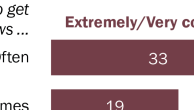By Chris Galdieri
Local news may not really look the same everywhere, but newscasts often make the same mistakes. Local news experts and project researchers looked at some of the more in-depth pieces in the study and found that even many of them fell prey to some chronic bad habits. Here is a catalogue of items local newscasters should guard against.
- Small Problems Get Hyped – Everyone has seen TV investigations exposing such big issues as dirty hotel bedding or bras that are too tight. Sure, there’s no such thing as a bad story, but this stuff trivializes investigative reporting. KCBS in Los Angeles rents a house for two months and wires it with a raft of hidden cameras to expose that you can’t really get your whole house carpet-cleaned for eight dollars. What important stories aren’t covered when resources are tied up in stories like this?
- Technology Doesn’t Serve Content – If people start noticing the visuals rather than the ideas they’re supposed to communicate, that’s a sure sign of trouble. Too many pieces used camera angles and effects that pull viewers away from the substance of the story. That carpet-cleaning story included a Tim Burton-esque shot of the reporter’s face peering into a mailbox as seen from the point of view of the mail. In an auto insurance story by KSTP in the Twin Cities, the video for a man-on-the-street sequence focused not on the motorist being questioned, but rather on his reflection in his car window. When does production get in the way? One clue is when the heavily produced video contradicts the voice-overs. KDNL in St. Louis illustrates one woman describing her heart attack with flashing ambulance lights and a flatlining heart monitor – even though the woman rode to the hospital in her sister’s car and survived. Another clue is when production goes over the top, like a Minneapolis story by KARE about acupuncture replete with exotic Chinese background music and montages of Chinese tapestries, intercut with physician interviews and footage of needles.
- Numbers Used Badly or Not at All – Numbers help put stories in context, but here local TV often falters. Too many stories failed to give any numbers. A piece by Boston’s WBZ about the brain disease “CJD” doesn’t say how many people are afflicted, only that a single local physician has seen two cases. Another by Minneapolis’ KSTP about police officers who failed to divulge criminal records on their applications never says how often it happens. Don’t fall into the trap of relying on anecdotes to establish trends. While leaving numbers out is a big problem, so is using them and mucking it up. A KNBC piece in Los Angeles about bilingual education confuses children who speak only Spanish with any students who are not bilingual, then giving a number that misrepresented state demographics by several million kids. To explore a proposed $400 million light rail system in Minneapolis, KARE sent a reporter to St. Louis to examine a similar new train service there. The story provided a way to look at how a project only in the planning stages might actually work. St. Louis’s system was largely a success, although it did not pay for itself. But St. Louis had more traffic problems in the first place, and its system was bigger than the one proposed for Minneapolis. The approach cut through the sound bite rhetoric that accompanies speculative issues and provided facts about light rail that people could believe.
- Claims and Hyperbole Go Unchallenged – Reporters are supposed to get the best quotes they can, but that doesn’t mean broad generalizations and sweeping claims should go unexamined. An otherwise strong story on gas pump emissions in Tucson by KOLD says retailers fear upgrading pumps will cost $60,000 a station and bankrupt small independents, but never mentions that the cost would probably be tax deductible and paid for with loans.
- Reporting Methods Are Unclear – A number of stories left viewers unable to tell how information and footage was gathered. Several stories, such as one about gay men “cruising” public restrooms by KRQE in Albuquerque or another about unfair employee personnel files by WHDH in Boston, include footage that may be of real people engaged in these practices, or may be staged. The rule is simple. Don’t deceive your audience about what you’re telling them or how you got it.
- No Follow Through – Story after story briefly mentioned tantalizing information and then failed to follow it up. Don’t raise questions without answering them. A report in St. Louis about bad nursing homes says caretakers earn less than hairdressers, but never explores the implications. That story about bilingual education waits until the end to raise the issue that school districts could get bilingual education money and not provide the programs. A Minneapolis report about the hardship a family suffers when a utility uses their front yard for power lines mentions only late in the piece that the company boosts its compensation offer to the family nearly 30 fold.
There are other bad habits. Misusing the terms “exclusive,” “live” and “investigation.” Creating “victims” and “villains.” Polarizing issues for the sake of drama or simplicity. Going to meaningless live standups hours after an event was over. Yet most of these bad habits share a common thread. They involve an intellectual laziness. It often comes from employing sometimes useful journalistic techniques in thoughtless or rote ways. Good production values help a story, but only if they clarify the content. Avoiding too many numbers can help keep stories clearer, but only if you’ve already provided adequate context. There is only one ultimate remedy: clear thinking.
Chris Galdieri, a research associate at the Project for Excellence in Journalism, is a writer with a background in online journalism. The analysis contained here is the product of a team of eight researchers and local news veterans who reviewed the tapes.




